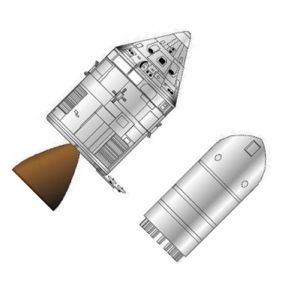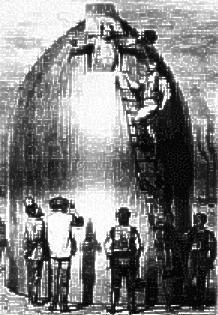
Home - Search - Browse - Alphabetic Index: 0- 1- 2- 3- 4- 5- 6- 7- 8- 9
A- B- C- D- E- F- G- H- I- J- K- L- M- N- O- P- Q- R- S- T- U- V- W- X- Y- Z
Jules Verne Moon Gun
 Apollo vs Verne Apollo Columbia spacecraft compared with Jules Verne's Columbiad |
Status: Design 1856.
The gun was poured into a 274 m deep well, with a bore of 2.74 m. The first 61 m of the barrel was filled with 122 metric tons of guncotton. This was supposed to propel the 2.74 m diameter shell to a velocity of 16.5 km/second. After deceleration going through the earth's atmosphere, the shell would have a residual velocity of 11 km/second, sufficient to reach the moon.
The shell was to be constructed of aluminum, with walls 0.3 m thick. The human passengers would be protected from the tremendous G forces of acceleration and deceleration by hydraulic and frangible shock absorbers.
Verne's analysis resulted in the following correct predictions:
- The United States would launch the first manned vehicle to circumnavigate the moon.
- The cost of the program would be $5,446,675 US dollars in 1865 (equivalent to $ 12.112 billion US dollars in 1969; Apollo cost $ 14.405 billion dollars up to the Apollo 8 circumnavigation mission).
- The circumlunar spacecraft would have a crew of three. The names of the crew were Ardan, Barbicane, and Nicholl (Anders, Borman and Lovell on Apollo 8; Aldrin, Armstrong, Collins on Apollo 11).
- The circumlunar spacecraft would be built predominately of aluminum and have a mass of 19,250 pounds (empty mass of the predominately aluminum Apollo 8 circumlunar spacecraft was 26,275 pounds).
- The cannon used to launch the spacecraft was called a Columbiad. The Apollo 11 command module was named Columbia.
- After considering 12 sites in Texas and Florida, Stone Hill, south of Tampa, Florida is selected in Verne's novel. One hundred years later NASA considered 7 launch sites and selecting Merritt Island, Florida. In both cases Brownsville, Texas was rejected as a site; politics played a major role in the site selection; and site criteria included a latitude below 28 degrees north and good access to the sea.
- Verne's spacecraft was launched in December, from latitude 27 deg 7 min North, 82 deg 9 min West Longitude. After a journey of 242 hours 31 minutes, including 48 hours in lunar orbit, the spacecraft splashed down in the Pacific Ocean at 20 deg 7 min North, 118 deg 39 min West, and was recovered by the US Navy vessel Susquehanna.
The crew of Apollo 8 was launched in December 100 years later, from latitude 28 deg 27 min North, longitude 80 deg 36 min W (132 miles / 213 km from Verne's site). After a journey of 147 hours 1 minute, including 20 hours 10 minutes in lunar orbit. The spacecraft splashed down in the Pacific Ocean (8 deg 10 min North, 165 deg 00 min West) and was recovered by the US Navy vessel Hornet.
Many of these similarities are due to the engineering analysis Verne's characters used to determine the design of the gun and its projectile:
The velocity necessary to reach the moon (essentially the escape velocity of the earth) could be calculated easily using Newtonian mechanics: "...by incontrovertible calculations I find that a projectile endowed with an initial velocity of 12,000 yards per second, and aimed at the moon, must necessarily reach it .."
The caliber of the projectile was established by the need to track the object by telescope at lunar distance:
"... a telescope on some elevated mountain...of 48,000 times (magnification), which should bring the moon within an apparent distance of five miles; and, in order to be visible, objects need not have a diameter of more than nine feet."
To keep the mass of the projectile within reason, it would have to be hollow:
"A solid shot of 108 inches would weigh more than 200,000 pounds, a weight evidently far too great. Still, as we must reserve a certain stability for our projectile, I propose to give it a weight of 20,000 pounds."
But a cast iron shell with sides of the thickness to withstand the gas pressure at launch would also be far too heavy. This lead to the conclusion that:
"Aluminum....... is easily wrought... is three times lighter than iron, and seems to have been created for the express purpose of furnishing us with the material for our projectile....but...the cost price of aluminum (is) extremely high....nine dollars a pound!"
The final calculations showed the projectile would be: "...of 108 inches in diameter, and twelve inches in thickness, would weigh, in cast-iron, 67,440 pounds; cast in aluminum, its weight will be reduced to 19,250 pounds... at nine dollars a pound, this projectile will cost....$173,050."
The projectile having been settled, the gun itself could then be sized:
"The problem before us is how to communicate an initial force of 12,000 yards per second to a shell of 108 inches in diameter, weighing 20,000 pounds....The resistance of the air is of little importance. The atmosphere of the earth does not exceed forty miles. Now, with the given rapidity, the projectile will have traversed this in five seconds, and the period is too brief for the resistance of the medium to be regarded otherwise than as insignificant...."
"It must evidently be, then, a gun of great range, since the length of the piece will increase the detention of the gas accumulated behind the projectile; but there is no advantage in passing certain limits....Ordinarily the length of a gun is twenty to twenty-five times the diameter of the shot, and its weight two hundred and thirty-five to two hundred and forty times that of the shot."
".... following this proportion for a projectile nine feet in diameter, weighing 30,000 pounds, the gun would only have a length of two hundred and twenty- five feet, and a weight of 7,200,000 pounds"....(this is not enough so it was proposed) "...to quadruple that length, and to construct a gun of nine hundred feet...." with a "...thickness of six feet..."
The gun would be emplaced in the earth:
"..... mounting a mass like that upon a carriage.... would be.... impracticable.... I think of sinking this engine in the earth alone, binding it with hoops of wrought iron, and finally surrounding it with a thick mass of masonry of stone and cement. The piece once cast, it must be bored with great precision, so as to preclude any possible windage. So there will be no loss whatever of gas, and all the expansive force of the powder will be employed in the propulsion." The gun would not be rifled: "...we require an enormous initial velocity; and you are well aware that a shot quits a rifled gun less rapidly than it does a smooth-bore."
Cast iron is selected for the barrel: "...cast iron costs ten times less than bronze; it is easy to cast, it runs readily from the molds of sand, it is easy of manipulation, it is at once economical of money and of time. ....Cast iron is very brittle.... but it possesses great resistance. ..the cannon will weigh 68,040 tons. And, at two cents a pound, it will cost ...two million five hundred and ten thousand seven hundred and one dollars."
Ordinary gunpowder would not do. The latest invention, guncotton, would be used as propellant: "...it imparts to projectiles a velocity four times superior to that of gunpowder..... in place of 1,600,000 pounds of powder, we shall have but 400,000 pounds of fulminating cotton; and since we can, without danger, compress 500 pounds of cotton into twenty-seven cubic feet, the whole quantity will not occupy a height of more than 180 feet within the bore of the Columbiad. In this way the shot will have more than 700 feet of bore to traverse under a force of 6,000,000,000 liters of gas before taking its flight toward the moon."
The location of the cannon was set by the requirements for a vertical shot: "..the gun must be fired...toward the zenith. Now the moon does not traverse the zenith, except in places situated between 0 degrees and 28 degrees of latitude. It.." was "...agreed that this experiment cannot and ought not to be tried anywhere but within the limits of the soil of the ... United States... as far as the 28th parallel of the north latitude... the southern portion of Texas and Florida. Florida, in its southern part, reckons no cities of importance... it is simply studded with forts raised against the roving Indians. One solitary town, Tampa Town, was able to put in a claim in favor of its situation. In Texas...Corpus Christi, in the county of Nueces, and all the cities situated on the Rio Bravo, Laredo, Comalites, San Ignacio on the Web, Rio Grande City on the Starr, Edinburgh in the Hidalgo, Santa Rita, Elpanda, Brownsville in the Cameron, formed an imposing league against the pretensions of Florida...."
Critics of the scheme "...maintained that it was absolutely impossible to impress upon any body whatever a velocity of 12,000 yards per second; that even with such a velocity a projectile of such a weight could not transcend the limits of the earth's atmosphere. Further still, even regarding the velocity to be acquired, and granting it to be sufficient, the shell could not resist the pressure of the gas developed by the ignition of 1,600,000 pounds of powder; and supposing it to resist that pressure, it would be less able to support that temperature; it would melt on quitting the Columbiad, and fall back in a red-hot shower upon the heads of the imprudent spectators".
Unlike later critics of Goddard's rocket propulsion, the critics of the Columbiad were right. Analysis in the next century would indicate how the gun could be redesigned to meet these objections...
Family: Gun-launched, orbital launch vehicle. Country: France. Bibliography: 47.
 | Verne's Moon Vehicle |
1865 - . Launch Vehicle: Jules Verne Moon Gun.
- Jules Verne's From the Earth to the Moon - .
Nation: France.
This was a seminal work that inspired most of the original rocket pioneers. Verne used real engineering analysis to arrive at the design of his cannon and manned moon projectible. As a result, at the time of the Apollo 8 and 11 missions it was noted that Verne had made a number of correct predictions about the actual missions....
Back to top of page
Home - Search - Browse - Alphabetic Index: 0- 1- 2- 3- 4- 5- 6- 7- 8- 9
A- B- C- D- E- F- G- H- I- J- K- L- M- N- O- P- Q- R- S- T- U- V- W- X- Y- Z
© 1997-2019 Mark Wade - Contact
© / Conditions for Use